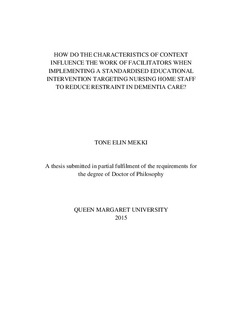| dc.description.abstract | This research is part of a larger study - a sequential mixed method education intervention targeting staff in 24 Nursing Homes (NHs) in Norway to reduce use of restraint and psychotropic drugs. Building on a previous successful intervention, we used the Promoting Action on Research Implementation in Health Services (PARIHS) prospectively to combine cluster randomized controlled trial, participatory action research (PAR) and ethnography to design and evaluate the effectiveness of 2 day staff education and 1 hour monthly coaching during 6 months in two rounds (12 x 2 NHs). In my research that is the primary focus of this thesis, four teams of eight facilitators facilitated the intervention and simultaneously participated in PAR to co-construct knowledge of hindering and promoting implementation factors. A ‘Creative Hermeneutic Knowledge Co- Production’ (CrHeKCoP) model blending paradigmatic and epistemological assumptions from critical and participatory worldviews was created and used in spirals of 10 mini-cycles of actions to co-construct knowledge of the implementation process. Findings and implications The CrHeKCoP- model enabled a critically creative approach to implementation as well as rigorous, transparent and authentic knowledge co-production based on multiple data sets from trial (n= 274), multi- step focus groups (4) and faciltiators’ reflection notes (84). The overall results showed that restraint-use was significantly reduced in both the intervention group (p = 0.025) and control group (p<0.001), with a tendency to a greater reduction in the control group. The PARIHS framework was valuable in designing and evaluating a mixed method intervention approach in a Norwegian context. My research confirmed the framework’s main elements. However, the findings point to some elements meriting further conceptualisation; first, the dynamism and reciprocal interaction between the elements. Second, to include individual staff member’s learning skills and motivation as a fourth element. Third, the ‘what’s and ‘how’s of leadership practice that promotes organisational readiness for change. Fourth, assumptions of successful knowledge use as effective integration within organisations and their systems. | en_GB |
